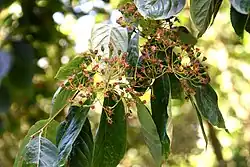Pourthiaea beauverdiana
| Pourthiaea beauverdiana | |
|---|---|

| |
| Scientific classification | |
| Kingdom: | Plantae |
| Clade: | Tracheophytes |
| Clade: | Angiosperms |
| Clade: | Eudicots |
| Clade: | Rosids |
| Order: | Rosales |
| Family: | Rosaceae |
| Genus: | Pourthiaea |
| Species: | P. beauverdiana
|
| Binomial name | |
| Pourthiaea beauverdiana | |
| Synonyms[1] | |
| |
Pourthiaea beauverdiana, known commonly as the Christmas berry, is a species of deciduous shrub or tree[2] It is native to central and southern China, Taiwan, northern Vietnam, and Bhutan in the eastern Himalaya.[1]
The species was first described as Photinia beauverdiana by Camillo Karl Schneider in 1906.[3] The species epithet honors Swiss botanist Gustave Beauverd (1867-1942).[2] In 1933 Sumihiko Hatusima placed the species in genus Pourthiaea as Pourthiaea beauverdiana.[1]
Description
P. beauverdiana has a height range from 6.1 to 9.1 m (20 to 30 ft) and is known for its remarkable red-orange colors and showy red berries.[2] It blooms from April to May and can tolerate temperatures down to −23 °C (−9 °F).[3] They have leaves that are serrate, elliptical, to ovate and tips that are acute to caudate.[2] They produce tiny, cup-shaped, orbicular white flowers with red fruits that produce up to four seeds.[2]
Habitat
The Christmas berry lives mountainside or woodland areas and thrives under full sun to partial shade.[2] The shadier it gets for this plant, the more susceptible it is to leaf spot disease (Entomosporium maculatum) and will have less flowering.[2] They grow best under medium moisture and can be resistant to droughts, deer, and rabbit.[2]
References
- ^ a b c "Pourthiaea beauverdiana (C.K.Schneid.) Hatus". Plants of the World Online. Royal Botanic Gardens, Kew. Retrieved 7 August 2025.
- ^ a b c d e f g h "Photinia beauverdiana - Plant Finder". www.missouribotanicalgarden.org. Retrieved 2023-10-04.
- ^ a b "Hortipedia - Photinia beauverdiana". en.hortipedia.com. Retrieved 2023-10-04.